engine BMW Z4 3.0I COUPE 2008 E86 Owner's Guide
[x] Cancel search | Manufacturer: BMW, Model Year: 2008, Model line: Z4 3.0I COUPE, Model: BMW Z4 3.0I COUPE 2008 E86Pages: 132, PDF Size: 3.23 MB
Page 98 of 132
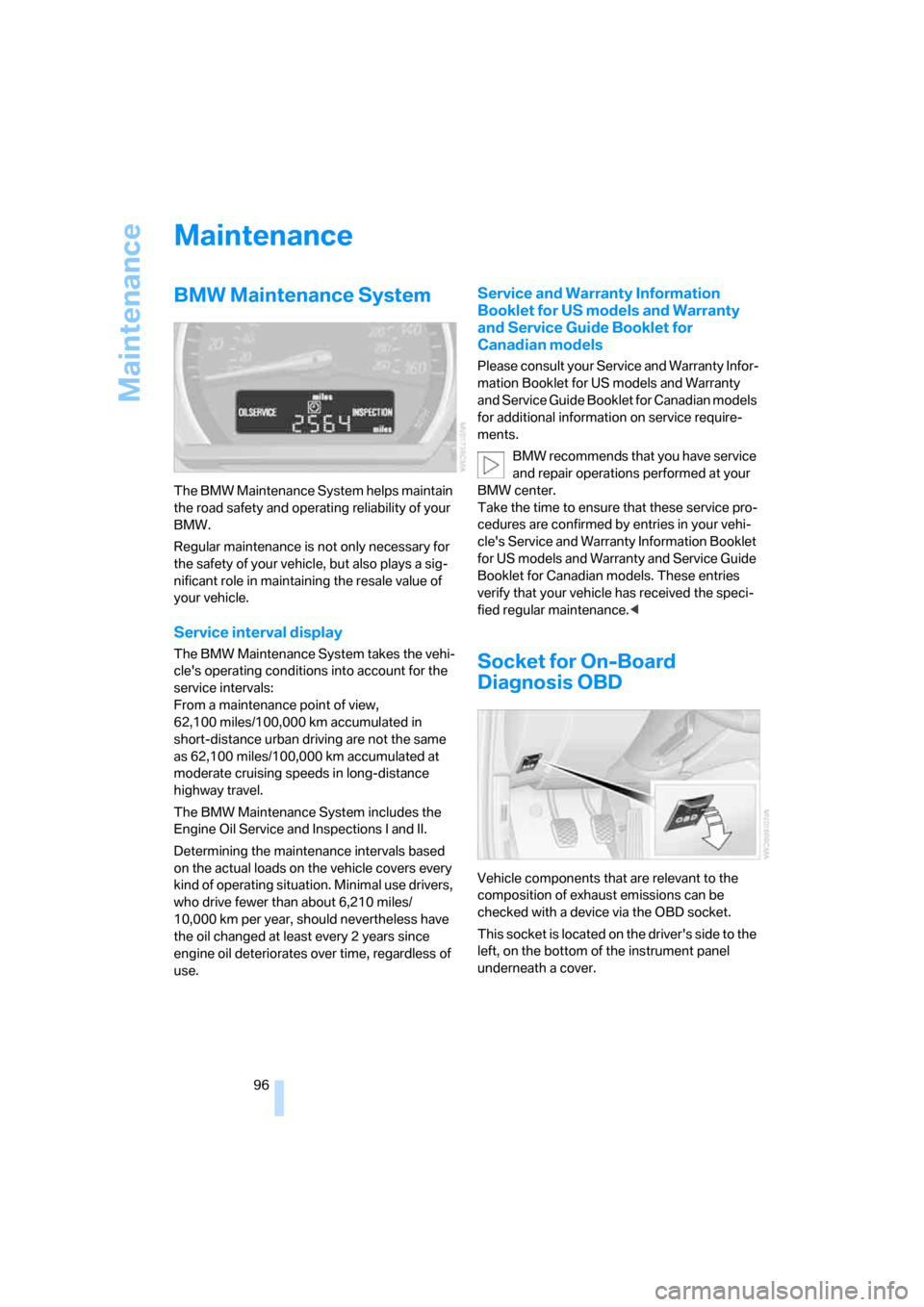
Maintenance
96
Maintenance
BMW Maintenance System
The BMW Maintenance System helps maintain
the road safety and operating reliability of your
BMW.
Regular maintenance is not only necessary for
the safety of your vehicle, but also plays a sig-
nificant role in maintaining the resale value of
your vehicle.
Service interval display
The BMW Maintenance System takes the vehi-
cle's operating conditions into account for the
service intervals:
From a maintenance point of view,
62,100 miles/100,000 km accumulated in
short-distance urban driving are not the same
as 62,100 miles/100,000 km accumulated at
moderate cruising speeds in long-distance
highway travel.
The BMW Maintenance System includes the
Engine Oil Service and Inspections I and II.
Determining the maintenance intervals based
on the actual loads on the vehicle covers every
kind of operating situation. Minimal use drivers,
who drive fewer than about 6,210 miles/
10,000 km per year, should nevertheless have
the oil changed at least every 2 years since
engine oil deteriorates over time, regardless of
use.
Service and Warranty Information
Booklet for US models and Warranty
and Service Guide Booklet for
Canadian models
Please consult your Service and Warranty Infor-
mation Booklet for US models and Warranty
and Service Guide Booklet for Canadian models
for additional information on service require-
ments.
BMW recommends that you have service
and repair operations performed at your
BMW center.
Take the time to ensure that these service pro-
cedures are confirmed by entries in your vehi-
cle's Service and Warranty Information Booklet
for US models and Warranty and Service Guide
Booklet for Canadian models. These entries
verify that your vehicle has received the speci-
fied regular maintenance.<
Socket for On-Board
Diagnosis OBD
Vehicle components that are relevant to the
composition of exhaust emissions can be
checked with a device via the OBD socket.
This socket is located on the driver's side to the
left, on the bottom of the instrument panel
underneath a cover.
Page 99 of 132
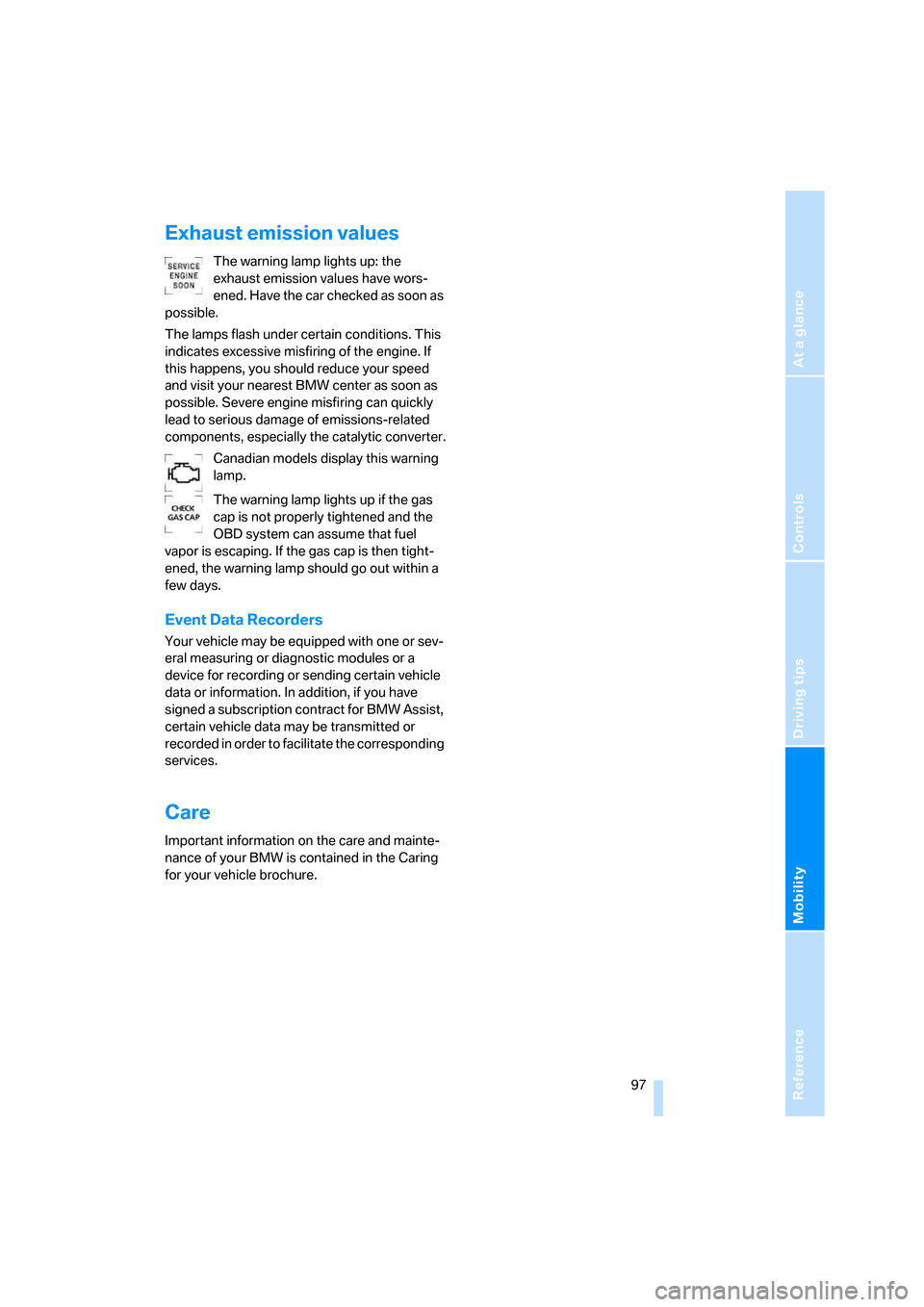
Reference
At a glance
Controls
Driving tips
Mobility
97
Exhaust emission values
The warning lamp lights up: the
exhaust emission values have wors-
ened. Have the car checked as soon as
possible.
The lamps flash under certain conditions. This
indicates excessive misfiring of the engine. If
this happens, you should reduce your speed
and visit your nearest BMW center as soon as
possible. Severe engine misfiring can quickly
lead to serious damage of emissions-related
components, especially the catalytic converter.
Canadian models display this warning
lamp.
The warning lamp lights up if the gas
cap is not properly tightened and the
OBD system can assume that fuel
vapor is escaping. If the gas cap is then tight-
ened, the warning lamp should go out within a
few days.
Event Data Recorders
Your vehicle may be equipped with one or sev-
eral measuring or diagnostic modules or a
device for recording or sending certain vehicle
data or information. In addition, if you have
signed a subscription contract for BMW Assist,
certain vehicle data may be transmitted or
recorded in order to facilitate the corresponding
services.
Care
Important information on the care and mainte-
nance of your BMW is contained in the Caring
for your vehicle brochure.
Page 104 of 132
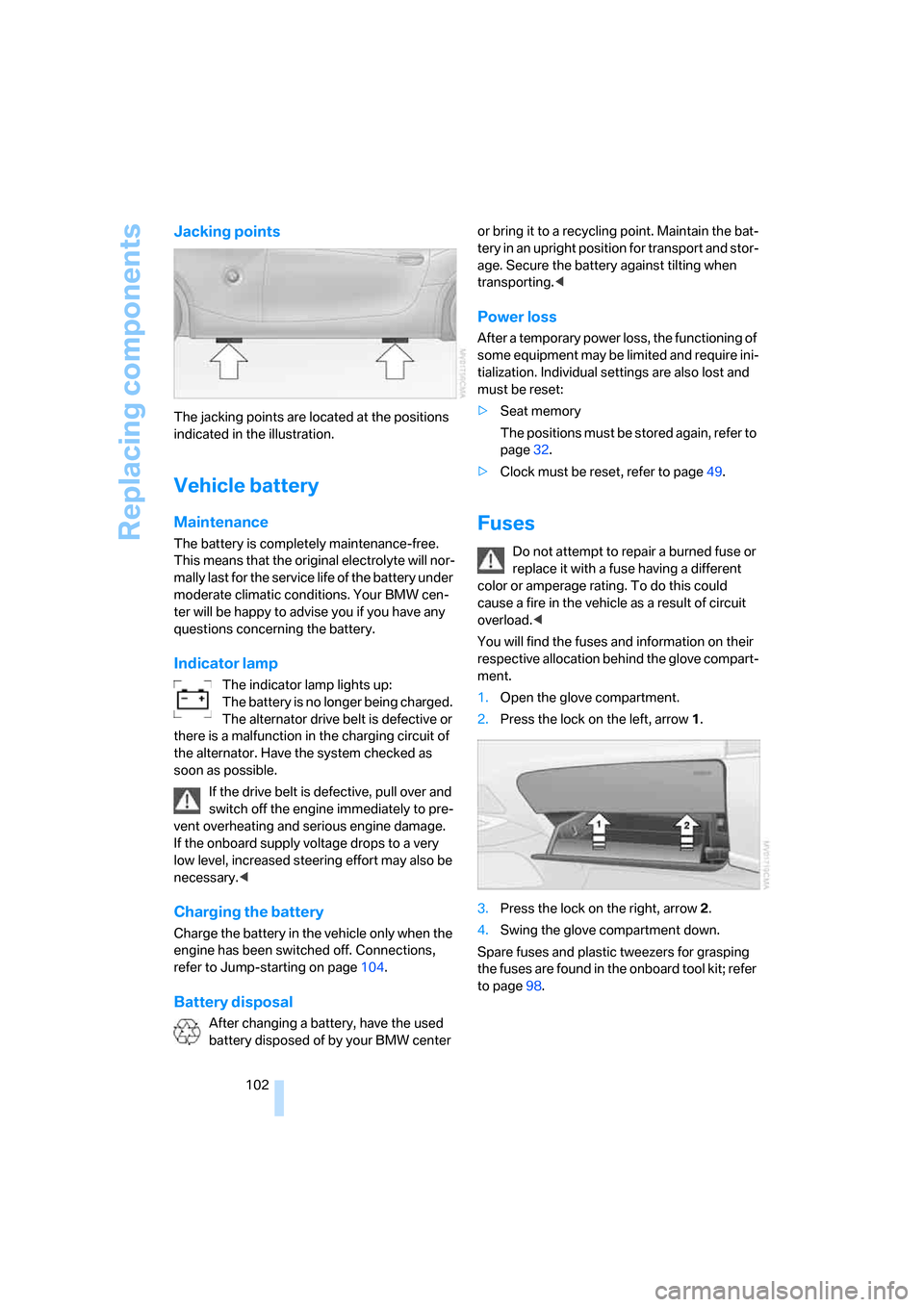
Replacing components
102
Jacking points
The jacking points are located at the positions
indicated in the illustration.
Vehicle battery
Maintenance
The battery is completely maintenance-free.
This means that the original electrolyte will nor-
mally last for the service life of the battery under
moderate climatic conditions. Your BMW cen-
ter will be happy to advise you if you have any
questions concerning the battery.
Indicator lamp
The indicator lamp lights up:
The battery is no longer being charged.
The alternator drive belt is defective or
there is a malfunction in the charging circuit of
the alternator. Have the system checked as
soon as possible.
If the drive belt is defective, pull over and
switch off the engine immediately to pre-
vent overheating and serious engine damage.
If the onboard supply voltage drops to a very
low level, increased steering effort may also be
necessary.<
Charging the battery
Charge the battery in the vehicle only when the
engine has been switched off. Connections,
refer to Jump-starting on page104.
Battery disposal
After changing a battery, have the used
battery disposed of by your BMW center or bring it to a recycling point. Maintain the bat-
tery in an upright position for transport and stor-
age. Secure the battery against tilting when
transporting.<
Power loss
After a temporary power loss, the functioning of
some equipment may be limited and require ini-
tialization. Individual settings are also lost and
must be reset:
>Seat memory
The positions must be stored again, refer to
page32.
>Clock must be reset, refer to page49.
Fuses
Do not attempt to repair a burned fuse or
replace it with a fuse having a different
color or amperage rating. To do this could
cause a fire in the vehicle as a result of circuit
overload.<
You will find the fuses and information on their
respective allocation behind the glove compart-
ment.
1.Open the glove compartment.
2.Press the lock on the left, arrow1.
3.Press the lock on the right, arrow2.
4.Swing the glove compartment down.
Spare fuses and plastic tweezers for grasping
the fuses are found in the onboard tool kit; refer
to page98.
Page 106 of 132
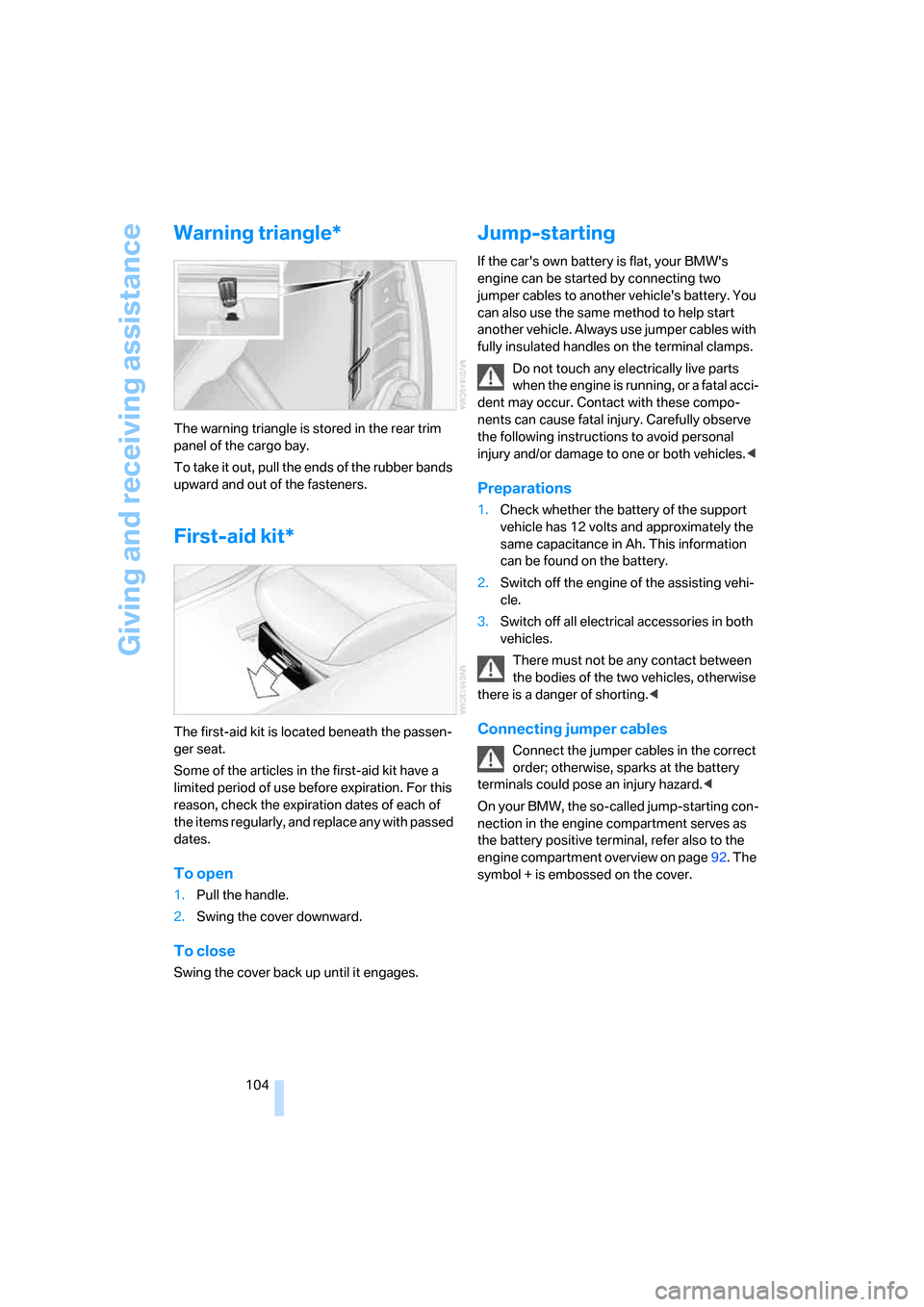
Giving and receiving assistance
104
Warning triangle*
The warning triangle is stored in the rear trim
panel of the cargo bay.
To take it out, pull the ends of the rubber bands
upward and out of the fasteners.
First-aid kit*
The first-aid kit is located beneath the passen-
ger seat.
Some of the articles in the first-aid kit have a
limited period of use before expiration. For this
reason, check the expiration dates of each of
the items regularly, and replace any with passed
dates.
To open
1.Pull the handle.
2.Swing the cover downward.
To close
Swing the cover back up until it engages.
Jump-starting
If the car's own battery is flat, your BMW's
engine can be started by connecting two
jumper cables to another vehicle's battery. You
can also use the same method to help start
another vehicle. Always use jumper cables with
fully insulated handles on the terminal clamps.
Do not touch any electrically live parts
when the engine is running, or a fatal acci-
dent may occur. Contact with these compo-
nents can cause fatal injury. Carefully observe
the following instructions to avoid personal
injury and/or damage to one or both vehicles.<
Preparations
1.Check whether the battery of the support
vehicle has 12 volts and approximately the
same capacitance in Ah. This information
can be found on the battery.
2.Switch off the engine of the assisting vehi-
cle.
3.Switch off all electrical accessories in both
vehicles.
There must not be any contact between
the bodies of the two vehicles, otherwise
there is a danger of shorting.<
Connecting jumper cables
Connect the jumper cables in the correct
order; otherwise, sparks at the battery
terminals could pose an injury hazard.<
On your BMW, the so-called jump-starting con-
nection in the engine compartment serves as
the battery positive terminal, refer also to the
engine compartment overview on page92. The
symbol + is embossed on the cover.
Page 107 of 132
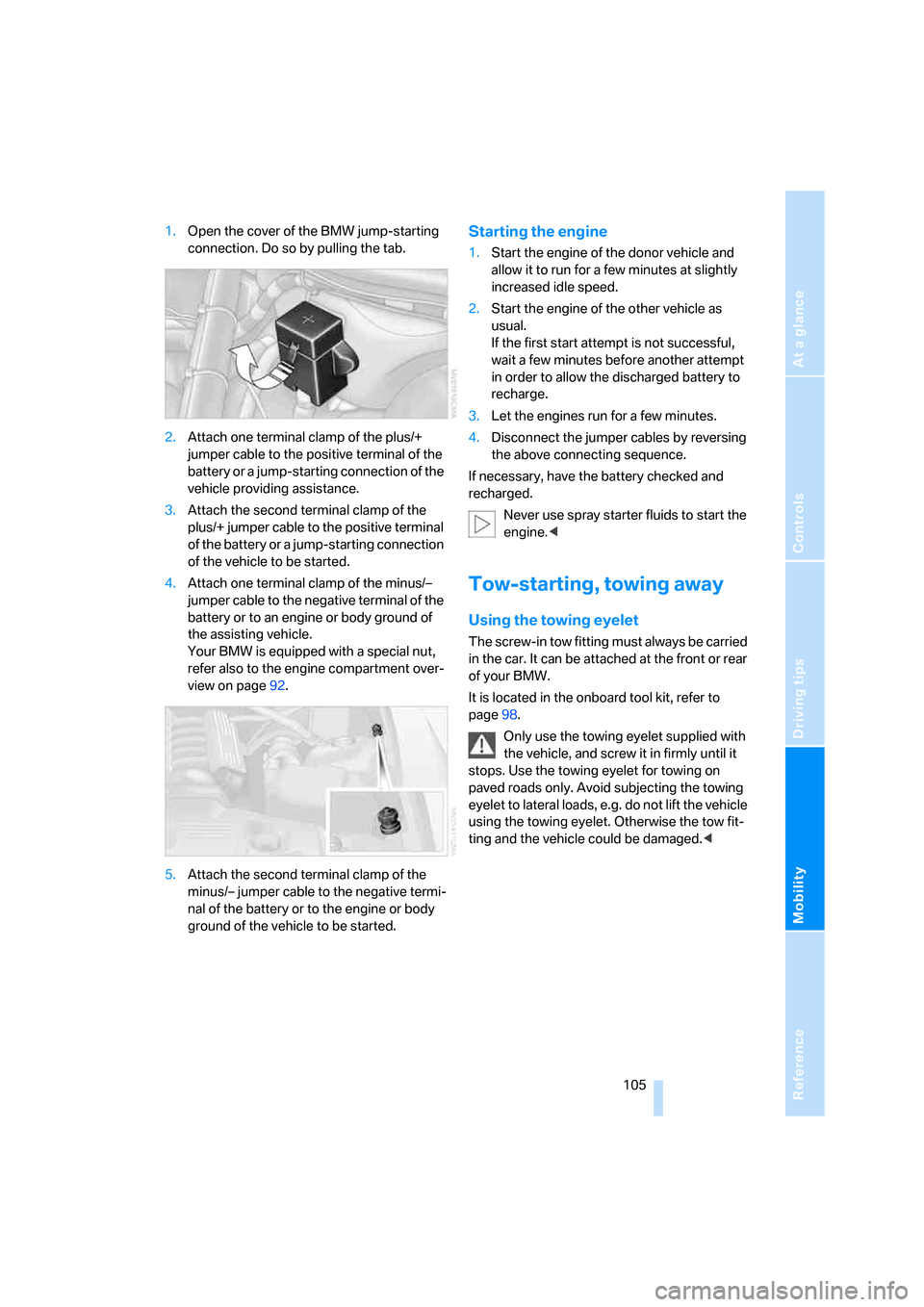
Reference
At a glance
Controls
Driving tips
Mobility
105
1.Open the cover of the BMW jump-starting
connection. Do so by pulling the tab.
2.Attach one terminal clamp of the plus/+
jumper cable to the positive terminal of the
battery or a jump-starting connection of the
vehicle providing assistance.
3.Attach the second terminal clamp of the
plus/+ jumper cable to the positive terminal
of the battery or a jump-starting connection
of the vehicle to be started.
4.Attach one terminal clamp of the minus/–
jumper cable to the negative terminal of the
battery or to an engine or body ground of
the assisting vehicle.
Your BMW is equipped with a special nut,
refer also to the engine compartment over-
view on page92.
5.Attach the second terminal clamp of the
minus/– jumper cable to the negative termi-
nal of the battery or to the engine or body
ground of the vehicle to be started.Starting the engine
1.Start the engine of the donor vehicle and
allow it to run for a few minutes at slightly
increased idle speed.
2.Start the engine of the other vehicle as
usual.
If the first start attempt is not successful,
wait a few minutes before another attempt
in order to allow the discharged battery to
recharge.
3.Let the engines run for a few minutes.
4.Disconnect the jumper cables by reversing
the above connecting sequence.
If necessary, have the battery checked and
recharged.
Never use spray starter fluids to start the
engine.<
Tow-starting, towing away
Using the towing eyelet
The screw-in tow fitting must always be carried
in the car. It can be attached at the front or rear
of your BMW.
It is located in the onboard tool kit, refer to
page98.
Only use the towing eyelet supplied with
the vehicle, and screw it in firmly until it
stops. Use the towing eyelet for towing on
paved roads only. Avoid subjecting the towing
eyelet to lateral loads, e.g. do not lift the vehicle
using the towing eyelet. Otherwise the tow fit-
ting and the vehicle could be damaged.<
Page 108 of 132
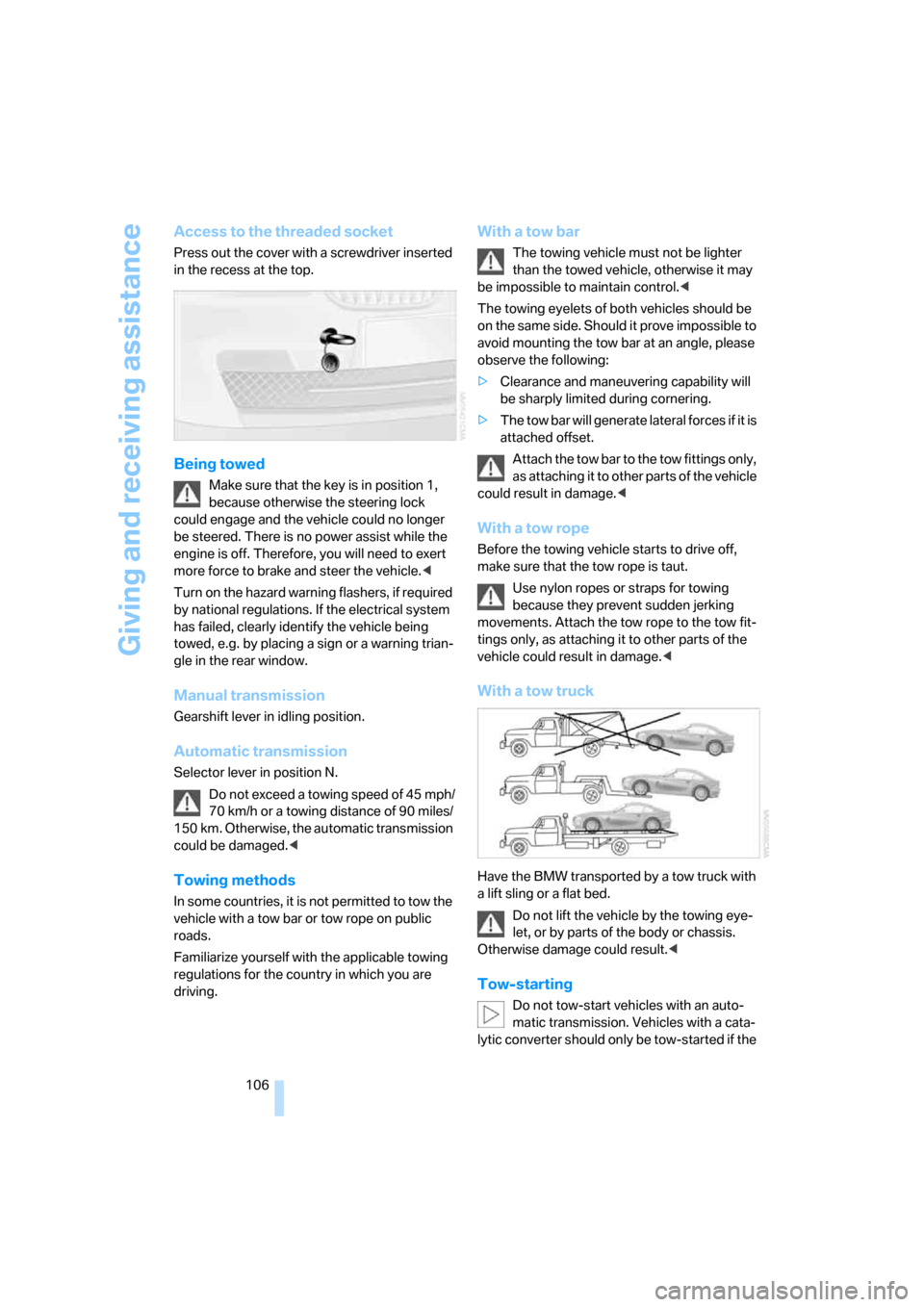
Giving and receiving assistance
106
Access to the threaded socket
Press out the cover with a screwdriver inserted
in the recess at the top.
Being towed
Make sure that the key is in position 1,
because otherwise the steering lock
could engage and the vehicle could no longer
be steered. There is no power assist while the
engine is off. Therefore, you will need to exert
more force to brake and steer the vehicle.<
Turn on the hazard warning flashers, if required
by national regulations. If the electrical system
has failed, clearly identify the vehicle being
towed, e.g. by placing a sign or a warning trian-
gle in the rear window.
Manual transmission
Gearshift lever in idling position.
Automatic transmission
Selector lever in position N.
Do not exceed a towing speed of 45 mph/
70 km/h or a towing distance of 90 miles/
150 km. Otherwise, the automatic transmission
could be damaged.<
Towing methods
In some countries, it is not permitted to tow the
vehicle with a tow bar or tow rope on public
roads.
Familiarize yourself with the applicable towing
regulations for the country in which you are
driving.
With a tow bar
The towing vehicle must not be lighter
than the towed vehicle, otherwise it may
be impossible to maintain control.<
The towing eyelets of both vehicles should be
on the same side. Should it prove impossible to
avoid mounting the tow bar at an angle, please
observe the following:
>Clearance and maneuvering capability will
be sharply limited during cornering.
>The tow bar will generate lateral forces if it is
attached offset.
Attach the tow bar to the tow fittings only,
as attaching it to other parts of the vehicle
could result in damage.<
With a tow rope
Before the towing vehicle starts to drive off,
make sure that the tow rope is taut.
Use nylon ropes or straps for towing
because they prevent sudden jerking
movements. Attach the tow rope to the tow fit-
tings only, as attaching it to other parts of the
vehicle could result in damage.<
With a tow truck
Have the BMW transported by a tow truck with
a lift sling or a flat bed.
Do not lift the vehicle by the towing eye-
let, or by parts of the body or chassis.
Otherwise damage could result.<
Tow-starting
Do not tow-start vehicles with an auto-
matic transmission. Vehicles with a cata-
lytic converter should only be tow-started if the
Page 109 of 132
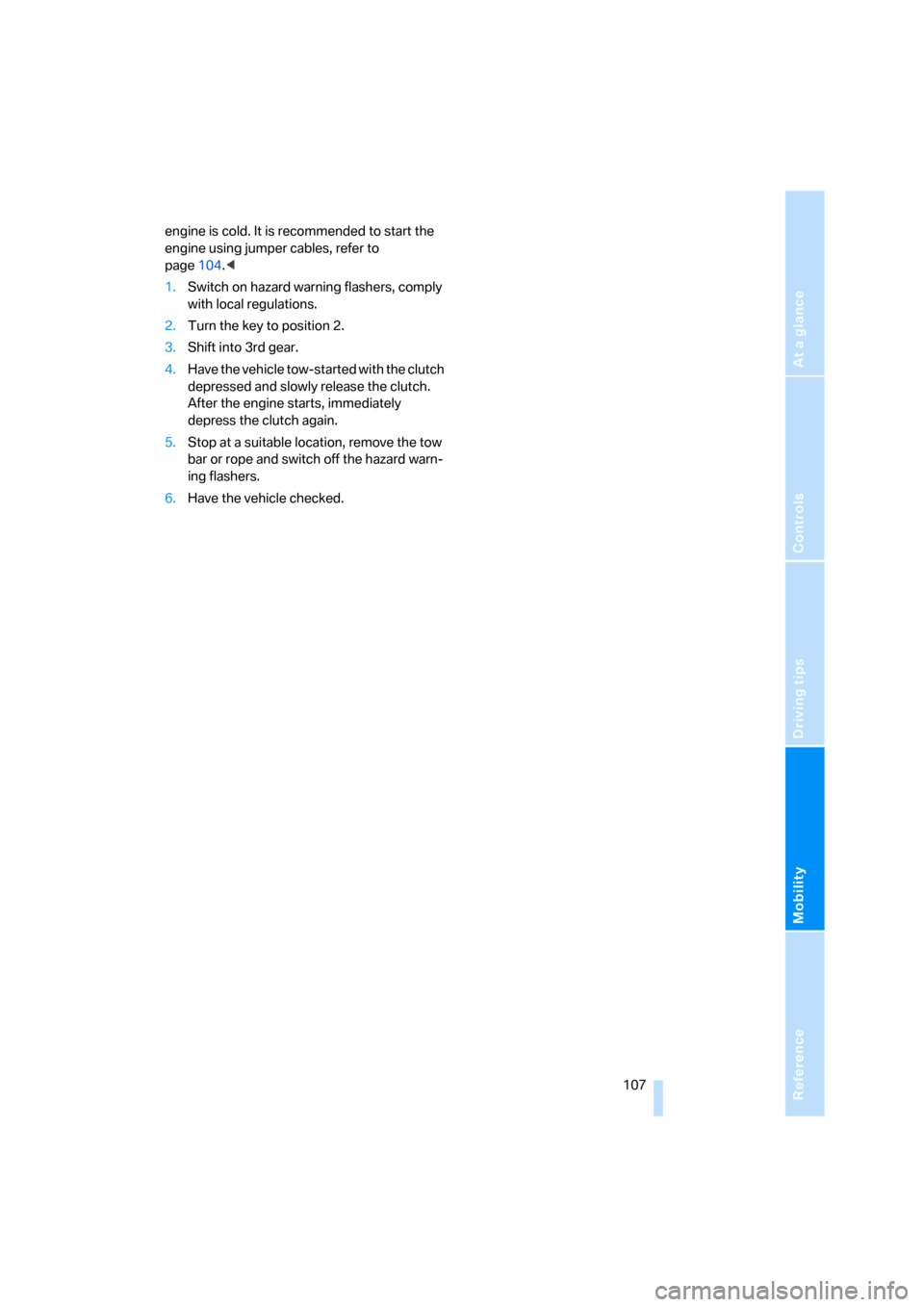
Reference
At a glance
Controls
Driving tips
Mobility
107
engine is cold. It is recommended to start the
engine using jumper cables, refer to
page104.<
1.Switch on hazard warning flashers, comply
with local regulations.
2.Turn the key to position 2.
3.Shift into 3rd gear.
4.Have the vehicle tow-started with the clutch
depressed and slowly release the clutch.
After the engine starts, immediately
depress the clutch again.
5.Stop at a suitable location, remove the tow
bar or rope and switch off the hazard warn-
ing flashers.
6.Have the vehicle checked.
Page 112 of 132
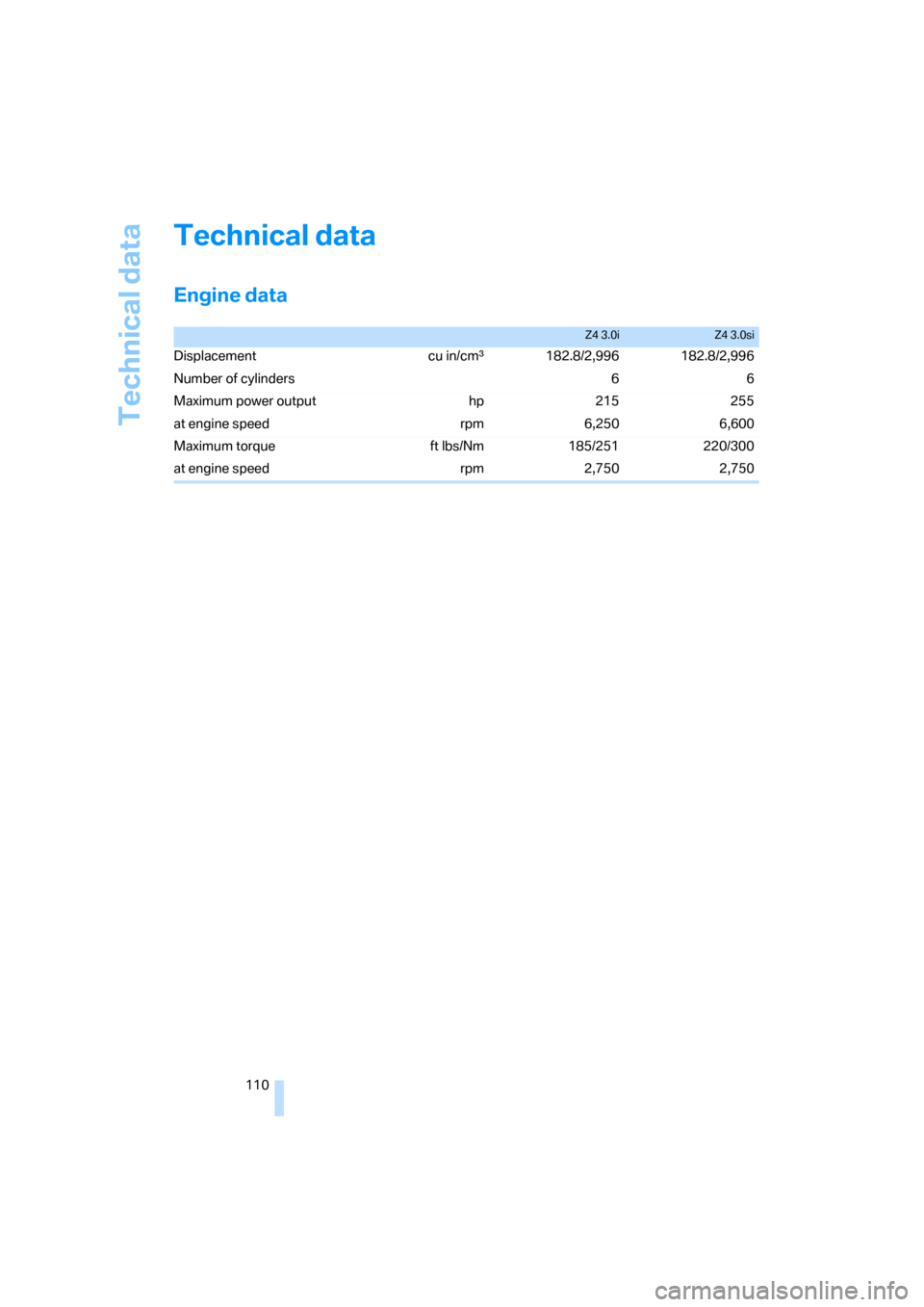
Technical data
110
Technical data
Engine data
Z4 3.0iZ4 3.0si
Displacement cu in/cmμ182.8/2,996 182.8/2,996
Number of cylinders 6 6
Maximum power output hp 215 255
at engine speed rpm 6,250 6,600
Maximum torque ft lbs/Nm 185/251 220/300
at engine speed rpm 2,750 2,750
Page 118 of 132
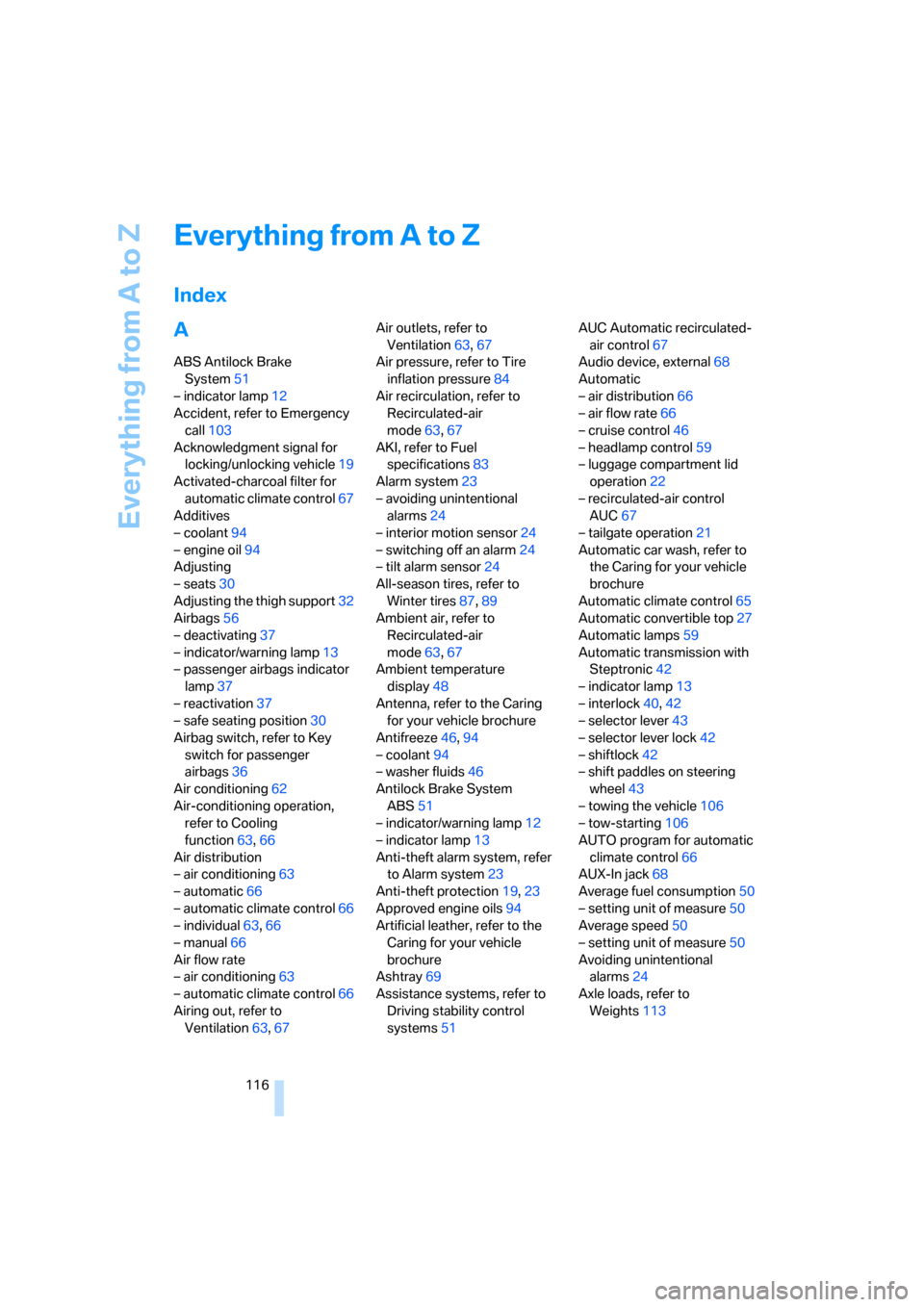
Everything from A to Z
116
Everything from A to Z
Index
A
ABS Antilock Brake
System51
– indicator lamp12
Accident, refer to Emergency
call103
Acknowledgment signal for
locking/unlocking vehicle19
Activated-charcoal filter for
automatic climate control67
Additives
– coolant94
– engine oil94
Adjusting
– seats30
Adjusting the thigh support32
Airbags56
– deactivating37
– indicator/warning lamp13
– passenger airbags indicator
lamp37
– reactivation37
– safe seating position30
Airbag switch, refer to Key
switch for passenger
airbags36
Air conditioning62
Air-conditioning operation,
refer to Cooling
function63,66
Air distribution
– air conditioning63
– automatic66
– automatic climate control66
– individual63,66
– manual66
Air flow rate
– air conditioning63
– automatic climate control66
Airing out, refer to
Ventilation63,67Air outlets, refer to
Ventilation63,67
Air pressure, refer to Tire
inflation pressure84
Air recirculation, refer to
Recirculated-air
mode63,67
AKI, refer to Fuel
specifications83
Alarm system23
– avoiding unintentional
alarms24
– interior motion sensor24
– switching off an alarm24
– tilt alarm sensor24
All-season tires, refer to
Winter tires87,89
Ambient air, refer to
Recirculated-air
mode63,67
Ambient temperature
display48
Antenna, refer to the Caring
for your vehicle brochure
Antifreeze46,94
– coolant94
– washer fluids46
Antilock Brake System
ABS51
– indicator/warning lamp12
– indicator lamp13
Anti-theft alarm system, refer
to Alarm system23
Anti-theft protection19,23
Approved engine oils94
Artificial leather, refer to the
Caring for your vehicle
brochure
Ashtray69
Assistance systems, refer to
Driving stability control
systems51AUC Automatic recirculated-
air control67
Audio device, external68
Automatic
– air distribution66
– air flow rate66
– cruise control46
– headlamp control59
– luggage compartment lid
operation22
– recirculated-air control
AUC67
– tailgate operation21
Automatic car wash, refer to
the Caring for your vehicle
brochure
Automatic climate control65
Automatic convertible top27
Automatic lamps59
Automatic transmission with
Steptronic42
– indicator lamp13
– interlock40,42
– selector lever43
– selector lever lock42
– shiftlock42
– shift paddles on steering
wheel43
– towing the vehicle106
– tow-starting106
AUTO program for automatic
climate control66
AUX-In jack68
Average fuel consumption50
– setting unit of measure50
Average speed50
– setting unit of measure50
Avoiding unintentional
alarms24
Axle loads, refer to
Weights113
Page 119 of 132
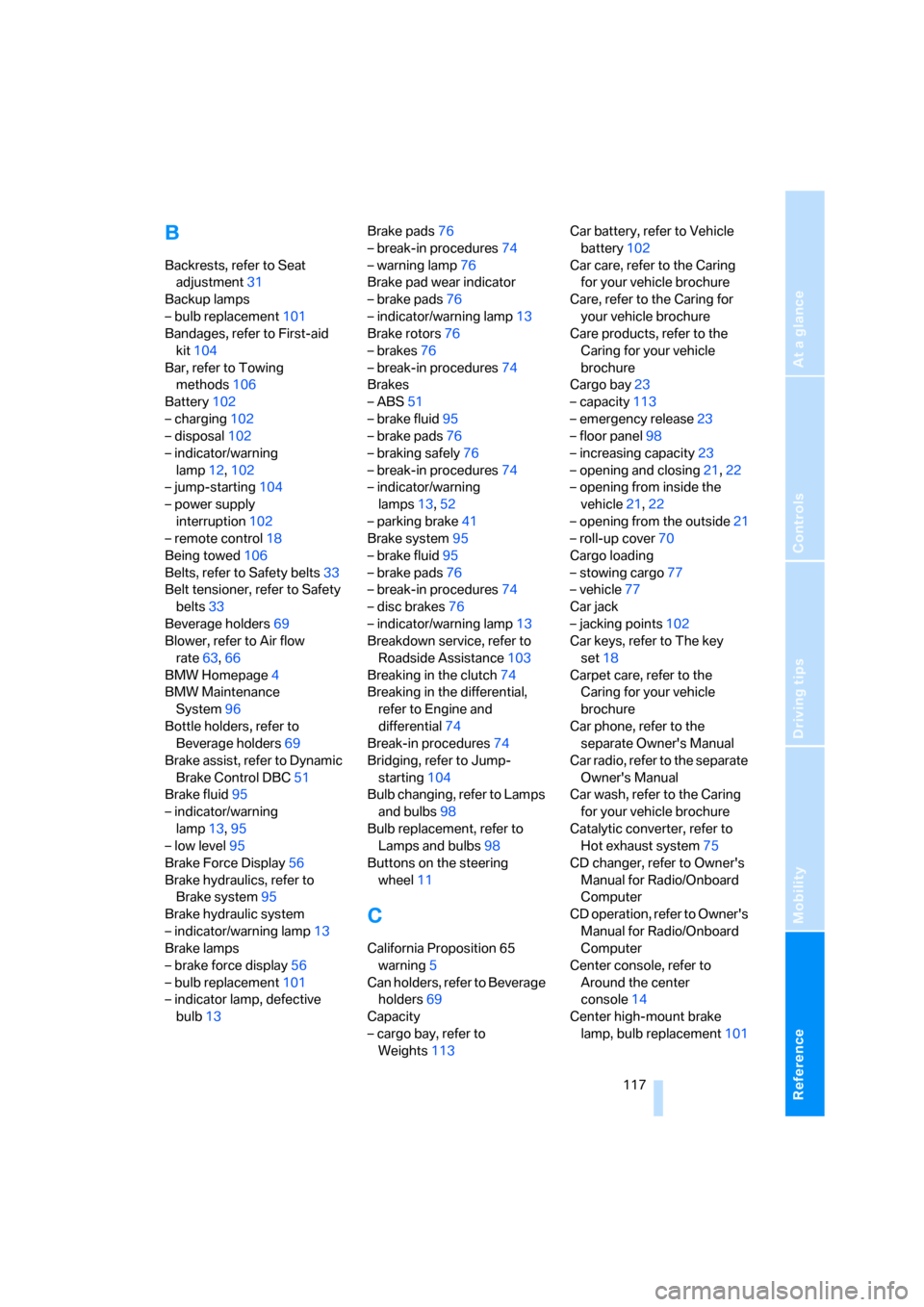
Reference
At a glance
Controls
Driving tips
Mobility
117
B
Backrests, refer to Seat
adjustment31
Backup lamps
– bulb replacement101
Bandages, refer to First-aid
kit104
Bar, refer to Towing
methods106
Battery102
– charging102
– disposal102
– indicator/warning
lamp12,102
– jump-starting104
– power supply
interruption102
– remote control18
Being towed106
Belts, refer to Safety belts33
Belt tensioner, refer to Safety
belts33
Beverage holders69
Blower, refer to Air flow
rate63,66
BMW Homepage4
BMW Maintenance
System96
Bottle holders, refer to
Beverage holders69
Brake assist, refer to Dynamic
Brake Control DBC51
Brake fluid95
– indicator/warning
lamp13,95
– low level95
Brake Force Display56
Brake hydraulics, refer to
Brake system95
Brake hydraulic system
– indicator/warning lamp13
Brake lamps
– brake force display56
– bulb replacement101
– indicator lamp, defective
bulb13Brake pads76
– break-in procedures74
– warning lamp76
Brake pad wear indicator
– brake pads76
– indicator/warning lamp13
Brake rotors76
– brakes76
– break-in procedures74
Brakes
– ABS51
– brake fluid95
– brake pads
76
– braking safely76
– break-in procedures74
– indicator/warning
lamps13,52
– parking brake41
Brake system95
– brake fluid95
– brake pads76
– break-in procedures74
– disc brakes76
– indicator/warning lamp13
Breakdown service, refer to
Roadside Assistance103
Breaking in the clutch74
Breaking in the differential,
refer to Engine and
differential74
Break-in procedures74
Bridging, refer to Jump-
starting104
Bulb changing, refer to Lamps
and bulbs98
Bulb replacement, refer to
Lamps and bulbs98
Buttons on the steering
wheel11
C
California Proposition 65
warning5
Can holders, refer to Beverage
holders69
Capacity
– cargo bay, refer to
Weights113Car battery, refer to Vehicle
battery102
Car care, refer to the Caring
for your vehicle brochure
Care, refer to the Caring for
your vehicle brochure
Care products, refer to the
Caring for your vehicle
brochure
Cargo bay23
– capacity113
– emergency release23
– floor panel98
– increasing capacity23
– opening and closing21,22
– opening from inside the
vehicle21,22
– opening from the outside21
– roll-up cover70
Cargo loading
– stowing cargo77
– vehicle77
Car jack
– jacking points102
Car keys, refer to The key
set18
Carpet care, refer to the
Caring for your vehicle
brochure
Car phone, refer to the
separate Owner's Manual
Car radio, refer to the separate
Owner's Manual
Car wash, refer to the Caring
for your vehicle brochure
Catalytic converter, refer to
Hot exhaust system75
CD changer, refer to Owner's
Manual for Radio/Onboard
Computer
CD operation, refer to Owner's
Manual for Radio/Onboard
Computer
Center console, refer to
Around the center
console14
Center high-mount brake
lamp, bulb replacement101